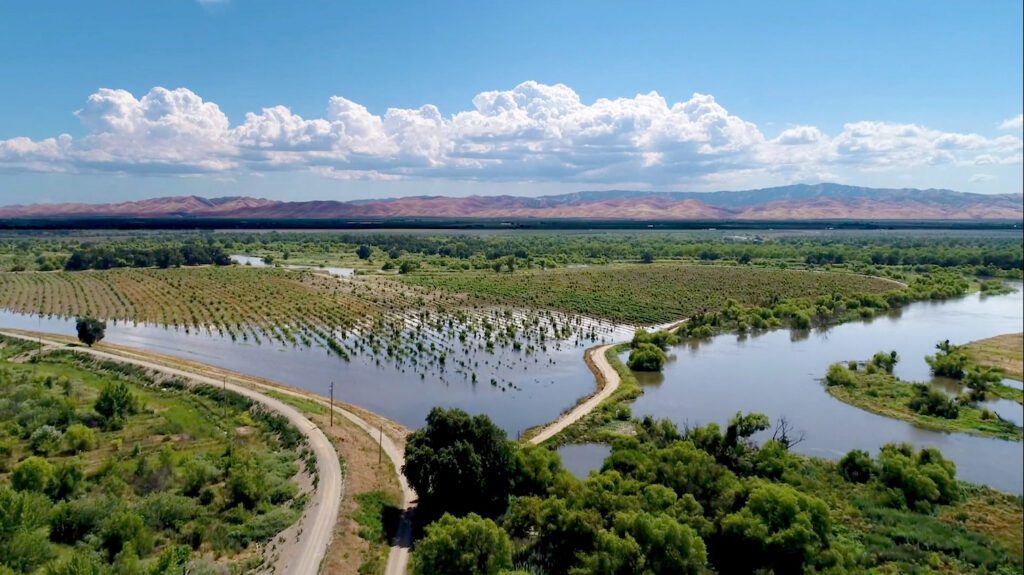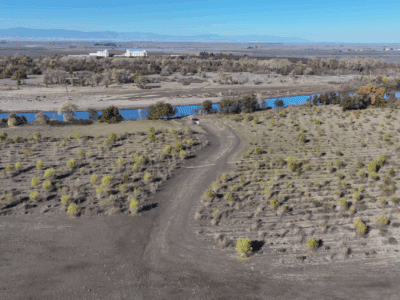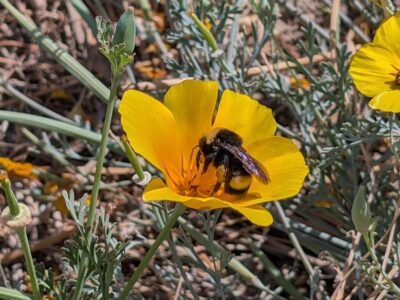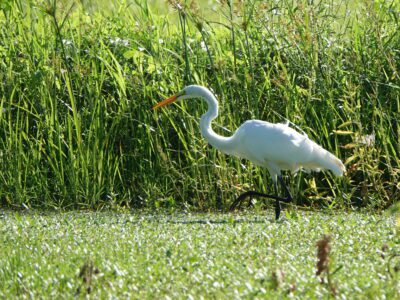
Erica Gies has always cared deeply about water. As a young reporter covering renewable energy, she wrote stories for The New York Times about the water-energy nexus. Once she did that, she said, she became more interested in water.
“Both water and energy can be kind of wonky, but on some level, people have to care about them because they’re so fundamental to everything we do,” she said. “For me, water was just way more interesting because it is a natural entity that has relationships with other natural entities and the more you learn about it, the more you realize there is to learn—it’s just kind of endlessly fascinating.”
Today, Gies is an award-winning independent journalist and author who has covered sustainability and water in outlets like The New York Times, Scientific American, Nature, The Economist, and National Geographic, among others. Her 2022 book, Water Always Wins: Thriving in an Age of Drought and Deluge, explores how science and hydrologists around the world manage water, ways in which the United States has historically managed (and mismanaged) water, and the “slow-water” movement—how allowing water to sit on the landscape longer and infiltrate underground helps in multiple ways, something River Partners advances in our work reconnecting rivers to their historic floodplains.
River Partners sat down with Gies recently to talk about bringing back floodplains, the importance of native seeds and plants in restoration, what California is doing—and what it could be doing—in managing water, and how optimistic she is that we can thrive in an era of weather whiplash.
How can decision makers be convinced to consider more slow-water projects like restoring floodplains?
People all around the world are finding ways to collaborate with water. Climate change can feel really overwhelming, but slow-water projects are local, they happen when people come together with other people in their own communities to find space for slow water. In doing that, they are softening their own impacts from flood and drought, but these approaches are also scalable. These are small, distributed projects across the landscape that cumulatively add up to a lot. So, it’s really a matter of changing the culture.
There’s an increasing body of science showing that these projects are cost-effective, they provide multiple benefits, and they can be somewhat self-sustaining if you can get space for the natural system to heal and maintain itself. There are people who are taking it to scale—Peru and China have national approaches, and California has statewide policies of floodplains being used as a tool in flood protection. The devil is in the details, and we still have a very strong influence from the dominant culture.
A lot of times, decision makers either don’t know about nature-based solutions or they think, “That’s nice, but it can’t be a real solution.” And that comes from this mindset of control we have in our culture. We have this hubris of presuming that we can control water, we can control nature, and that our needs are most important. But that way of thinking has really created so many of the problems we’re facing today. Increasingly, people are starting to understand that and the most powerful tool for change is one community doing this and having success with it and their neighboring community seeing that and thinking, “Maybe we could do that, too.”
You dedicate an entire chapter in your book to beavers—what role do they play in water management?
Beavers are very important natural water managers. California is a little late to the game in terms of Western states, but Washington State was really on the cutting edge in the modern era. Of course, in the early 20th century, Idaho and California did some beaver relocations, including parachuting beavers into the backcountry, but in the 1990s, Washington State started reintroducing beavers to areas to use them to repair damaged stream systems and to hold water on the landscape over a longer period. Your community probably knows that before the beavers were hunted nearly to extinction, North America was a much wetter continent, and about 10 percent of it was beaver-created wetlands.
In the West, we tend to think of streams as running seasonally, only in the winter when it rains. But historically, a lot of streams and wetlands had water year-round and that was because they were supplied by a healthy groundwater table that wasn’t overexploited or not allowed to recharge naturally, and beavers played a big role in that. So belatedly, California is coming around to this. The argument that beavers weren’t native to California because they had been killed before a lot of settlers came was disproven. But California has made a big step in recent years allocating money for five state-level jobs within the California Department of Fish and Wildlife to facilitate beaver reintroduction around the state, and they’re starting to do some relocations and working with Tribes. I think that’s a positive development.
[River Partners has witnessed an uptick in beaver populations finding new homes in and along the floodplains we continue to restore statewide, especially in the Central Valley, which helps increase the ecosystem benefits of our efforts.]

What could California state leadership be doing to improve its water equity and management policies and practices?
There’s this constant conversation in California asking, “Do we have enough water?” In fact, we have plenty of water, but the question is, “What are we doing with that water?” Unfortunately, the vast majority of it—something like 80 percent of human-use water in California—goes to agriculture. Some of that is going to export to the other side of the world and some of that is chasing optimal profits, as opposed to what people really need. I think there’s a lot of room to reallocate that water.
I know that that’s a very touchy subject, but increasingly it is being forced to happen. Australia had to go through it, Colorado has gone through it, and it seems like political will is shifting a bit in California to open those kinds of conversations, particularly when you think about equity. And when I talk about equity, I think it’s important to remember the nonhumans that are also part of our community. That can be anathema to the dominant culture, which is very, some would say, human supremacist.
Putting ourselves first isn’t working, and we’re seeing that fail increasingly often. The truth is that nonhumans play critical roles in keeping the natural systems functioning. It’s a complex systems relationship and when we make space for other entities—water, plants, animals—those systems can be healthy and can continue to support ourselves.
And truthfully, the reason why our “us-first” approach has worked as long as it has to the extent it has is because we’ve had a lot of buffer in these natural systems, but we don’t really have that any longer. Humans have altered and damaged 75 percent of land on Earth. Yes, climate change is making flood and drought more extreme and yes, climate change is altering the water cycle, but our land-use choices are also playing a significant role in that, and when you look at the global scale, you begin to understand that.
As much as 87 percent of the world’s wetlands have been drained and filled, two-thirds of the world’s large rivers have been dammed and diverted, and in the footprint of our cities, pavement and asphalt have doubled just since 1992. Floodplain encroachment since 1992 has increased, covering an area the size of Ukraine. In all of these ways, we’re taking space away from water, particularly slow water, wetlands, floodplains, mountain meadows, and forests, places where water is able to slow on the land, to infiltrate underground, to become part of those complex water cycle processes.
Are you optimistic we can figure out how to thrive in an age of drought and deluge?
I’m optimistic we can dramatically improve what we’re doing.
There’s so much room to improve from the way we have been doing things, and people all around the world from really different cultures are already doing it and showing the way. I do think that in our dominant system, we have narratives about humans as most important, as rich people’s right to continue to become richer as most important, that are fundamentally misaligned with sustainability. Our system is not set up to provide enough for everyone.
One of my worries about nature-based solutions is something like the trillion trees movement—it’s the idea that, “Trees store carbon, let’s plant a trillion trees.” A 2005 meta study in Science found that a lot of these tree-planting projects in fact took water away from the local watershed. That’s because they were eucalyptus and pine plantations, they weren’t native. In fact, a lot of emerging science shows that if you’re restoring natural forests and in places where forests belong, it can actually have a very positive impact on the water cycle because trees help water infiltrate, they evapotranspire it, and they provide on average 40 percent of the rain over continents. So, a lot of our drought is due to the way in which we’ve denuded the landscape.
Even with nature-based solutions, our culture has a tendency toward that single focus, like, “We want to store carbon, let’s plant trees that will store carbon as quickly as possible, we have to optimize it!” But, they’re not looking at those complex systems and relationships, so they’re making things worse. That’s something I’m concerned about, and I hope the more we can talk about how these systems actually work, the more we can encourage people to get more in touch with nature and get to know our nonhuman neighbors in a meaningful way, and hopefully we won’t make those types of mistakes.








